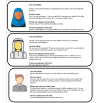Democratizing the Development of Chatbots to Improve Public Health: Feasibility Study of COVID-19 Misinformation
- PMID: 37290040
- PMCID: PMC10760512
- DOI: 10.2196/43120
Democratizing the Development of Chatbots to Improve Public Health: Feasibility Study of COVID-19 Misinformation
Abstract
Background: Chatbots enable users to have humanlike conversations on various topics and can vary widely in complexity and functionality. An area of research priority in chatbots is democratizing chatbots to all, removing barriers to entry, such as financial ones, to help make chatbots a possibility for the wider global population to improve access to information, help reduce the digital divide between nations, and improve areas of public good (eg, health communication). Chatbots in this space may help create the potential for improved health outcomes, potentially alleviating some of the burdens on health care providers and systems to be the sole voices of outreach to public health.
Objective: This study explored the feasibility of developing a chatbot using approaches that are accessible in low- and middle-resource settings, such as using technology that is low cost, can be developed by nonprogrammers, and can be deployed over social media platforms to reach the broadest-possible audience without the need for a specialized technical team.
Methods: This study is presented in 2 parts. First, we detailed the design and development of a chatbot, VWise, including the resources used and development considerations for the conversational model. Next, we conducted a case study of 33 participants who engaged in a pilot with our chatbot. We explored the following 3 research questions: (1) Is it feasible to develop and implement a chatbot addressing a public health issue with only minimal resources? (2) What is the participants' experience with using the chatbot? (3) What kinds of measures of engagement are observed from using the chatbot?
Results: A high level of engagement with the chatbot was demonstrated by the large number of participants who stayed with the conversation to its natural end (n=17, 52%), requested to see the free online resource, selected to view all information about a given concern, and returned to have a dialogue about a second concern (n=12, 36%).
Conclusions: This study explored the feasibility of and the design and development considerations for a chatbot, VWise. Our early findings from this initial pilot suggest that developing a functioning and low-cost chatbot is feasible, even in low-resource environments. Our results show that low-resource environments can enter the health communication chatbot space using readily available human and technical resources. However, despite these early indicators, many limitations exist in this study and further work with a larger sample size and greater diversity of participants is needed. This study represents early work on a chatbot in its virtual infancy. We hope this study will help provide those who feel chatbot access may be out of reach with a useful guide to enter this space, enabling more democratized access to chatbots for all.
Keywords: COVID-19; chatbot; conversational agent; infodemic; misinformation; motivational interviewing; online health information; social media; usability study; vaccine hesitancy; vaccine misinformation.
©Leigh Powell, Radwa Nour, Randa Sleibi, Hanan Al Suwaidi, Nabil Zary. Originally published in JMIR Human Factors (https://humanfactors.jmir.org), 28.12.2023.
Conflict of interest statement
Conflicts of Interest: NZ was Editor-in-Chief of JMIR Serious Games and JMIR Medical Education at the time of submission and acceptance of this publication.
Figures









References
-
- Adamopoulou E, Moussiades L. An overview of chatbot technology. In: Maglogiannis I, Iliadis L, Pimenidis E, editors. Artificial Intelligence Applications and Innovations. Cham: Springer International Publishing; 2020. pp. 373–383.
-
- Jovanovic M, Baez M, Casati F. Chatbots as conversational healthcare services. IEEE Internet Comput. 2021 May;25(3):44–51. doi: 10.1109/mic.2020.3037151. - DOI
-
- Ramesh K, Ravishankaran S, Joshi A, Chandrasekaran K. A survey of design techniques for conversational agents. In: Kaushik S, Gupta D, Kharb L, Chahal D, editors. Information, Communication and Computing Technology. Singapore: Springer; 2017. pp. 336–350.
-
- Powell L, Nizam MZ, Nour R, Zidoun Y, Sleibi R, Kaladhara Warrier S, Al Suwaidi H, Zary N. Conversational agents in health education: protocol for a scoping review. JMIR Res Protoc. 2022 Apr 19;11(4):e31923. doi: 10.2196/31923. https://www.researchprotocols.org/2022/4/e31923/ v11i4e31923 - DOI - PMC - PubMed
-
- 5 Levels of conversational AI - 2020 update. Rasa. [2022-08-30]. https://rasa.com blog/5-levels-of-conversational-ai-2020-update/
Publication types
MeSH terms
LinkOut - more resources
Full Text Sources
Medical

